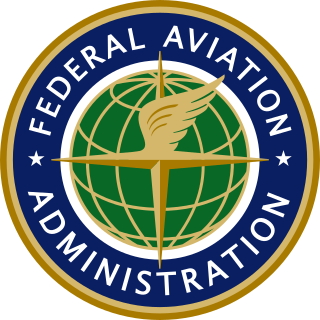Related Research Articles

Surveillance aircraft are aircraft used for surveillance. They are primarily operated by military forces and government agencies in roles including intelligence gathering, maritime patrol, battlefield and airspace surveillance, observation, and law enforcement.
The Federal Aviation Regulations (FARs) are rules prescribed by the Federal Aviation Administration (FAA) governing all aviation activities in the United States. The FARs comprise Title 14 of the Code of Federal Regulations. A wide variety of activities are regulated, such as aircraft design and maintenance, typical airline flights, pilot training activities, hot-air ballooning, lighter-than-air aircraft, human-made structure heights, obstruction lighting and marking, model rocket launches, commercial space operations, model aircraft operations, unmanned aircraft systems (UAS) and kite flying. The rules are designed to promote safe aviation, protecting pilots, flight attendants, passengers and the general public from unnecessary risk.

Aerial photography is the taking of photographs from an aircraft or other airborne platforms. When taking motion pictures, it is also known as aerial videography.

A radio-controlled aircraft is a small flying machine that is radio controlled by an operator on the ground using a hand-held radio transmitter. The transmitter continuously communicates with a receiver within the craft that sends signals to servomechanisms (servos) which move the control surfaces based on the position of joysticks on the transmitter. The control surfaces, in turn, directly affect the orientation of the plane.

In real estate, air rights are the property interest in the "space" above the Earth's surface. Generally speaking, owning or renting land or a building includes the right to use and build in the space above the land without interference by others.

First-person view (FPV), also known as remote-person view (RPV), or video piloting, is a method used to control a radio-controlled vehicle from the driver or pilot's viewpoint. Most commonly it is used to pilot a radio-controlled aircraft or other type of unmanned aerial vehicle (UAV) such as a military drone. The operator gets a first-person perspective from an onboard camera that feeds video to FPV goggles or a monitor. More sophisticated setups include a pan-and-tilt gimbaled camera controlled by a gyroscope sensor in the pilot's goggles and with dual onboard cameras, enabling a true stereoscopic view.
The Next Generation Air Transportation System (NextGen) is the current U.S. Federal Aviation Administration (FAA) program to modernize the National Airspace System (NAS). The FAA began work on NextGen improvements in 2007 and plans to finish implementation by 2030. Modernization goals include using new technologies and procedures to increase NAS safety, efficiency, capacity, access, flexibility, predictability, and resilience while reducing aviation's environmental impact.
Drone journalism is the use of drones, or unmanned aircraft systems (UAS), for journalistic purposes. According to the Federal Aviation Administration, "an unmanned aircraft is a device that is used, or is intended to be used, for flight in the air with no onboard pilot".

The FISA Improvements Act is a proposed act by Senator Dianne Feinstein, Chair of the Senate Intelligence Committee. Prompted by the disclosure of NSA surveillance by Edward Snowden, it would establish the surveillance program as legal, but impose some limitations on availability of the data. Opponents say the bill would codify warrantless access to many communications of American citizens for use by domestic law enforcement.

AC 91–57 is an FAA Advisory Circular (AC) that provides interim safety guidance to individuals operating unmanned aircraft, commonly known as drones, but inclusive of flying model aircraft, for recreational purposes in the National Airspace System of the United States.
The US Federal Aviation Administration has adopted the name small unmanned aircraft system (sUAS) to describe aircraft systems without a flight crew on board weighing less than 55 pounds. More common names include UAV, drone, remotely piloted vehicle (RPV), remotely piloted aircraft (RPA), and remotely operated aircraft (ROA). These unmanned aircraft flown in the USA's National Airspace System must operate under the rules of a Community Based Organization for recreational purposes or 14 CFR Part 107 for commercial operations. All UAVs weighing more than 250 grams flown for any purpose must be registered with the FAA.

Regulation of unmanned aerial vehicles (UAVs) involves setting safety requirements, outlining regulations for the safe flying of drones, and enforcing action against errant users.
Unmanned aerial vehicles (UAVs) have been used for domestic police work in various countries around the world since the mid-2000s. Their appeal comes from their small size, lack of crew, and lower cost compared to police helicopters. UAVs may be used for search and rescue operations, aerial patrols, and other roles that are usually served by crewed police aircraft. UAVs can be powerful surveillance tools by carrying camera systems capable of license plate scanning and thermal imaging, as well as radio equipment and other sensors. While a vast majority of law enforcement UAVs are unarmed, documents obtained by digital rights group Electronic Frontier Foundation indicated the U.S. Customs and Border Protection would consider arming their UAVs with "non-lethal weapons designed to immobilize" targets.

The Commercial UAS Modernization Act is a bill introduced in the 114th Congress by U.S. Senators Cory Booker (D-NJ) and John Hoeven (R-ND) that would create temporary guidelines for the use of unmanned aircraft systems and regulations for the commercial drone industry. Most commercial use of drones in the U.S. is currently banned by the Federal Aviation Administration (FAA).

An agricultural drone is an unmanned aerial vehicle used in agriculture operations, mostly in yield optimization and in monitoring crop growth and crop production. Agricultural drones provide information on crop growth stages, crop health, and soil variations. Multispectral sensors are used on agricultural drones to image electromagnetic radiation beyond the visible spectrum, including near-infrared and short-wave infrared.

The FAA Reauthorization Act of 2018 is a United States federal law, enacted during the 115th United States Congress, which reauthorizes the Federal Aviation Administration (FAA) and other programs till the end of fiscal year 2023. The bill was passed by Congress on October 3, 2018, and was signed by President Donald Trump on October 5, 2018.
Human bycatch is a term for people who are unintentionally caught on film, in photos, or acoustically recorded on equipment used to monitor wildlife or habitats for the purpose of conservation, or environmental law enforcement. It comes from the term bycatch, which is used in fishing practices to designate non-target species that are caught in a fishing net. Nearly every remote monitoring study contains human by-catch, yet there are no standardized rules or policies regarding what the researchers can or should do with their data.
The 2019–20 Colorado drone sightings were a series of widely sighted unidentified drones observed in the skies of northeastern Colorado and western Nebraska between December 2019 and January 2020. According to witness reports, the drones flew in grid formations in groups of up to 19 and were visible at night between 6 and 10 pm. The Federal Aviation Administration (FAA), FBI, and local law enforcement investigated the sightings, but have not yet determined the operator of the drones. Flying drones at night without a waiver from the FAA is a violation of federal law.
Remote ID is a regulation of the US Federal Aviation Administration (FAA) that requires registered drones—unmanned aircraft systems or UAS—to broadcast certain identifying and location information during flight, akin to a digital license plate for drones. Remote ID regulations are codified in Part 89 of the Code of Federal Regulations.

RaceDayQuads, LLC v. FAA, also known as Brennan v. Dickson, was a 2022 United States court case heard in the DC Federal Court of Appeals in which the online store RaceDayQuads attempted to challenge the constitutionality and legality of the Federal Aviation Administration's recent remote ID ruling and decision to require that all unmanned aerial vehicles (drones) in US airspace to continuously transmit the location of both the drone and its operator during all operations. The suit, filed by RaceDayQuads owner and CEO Tyler Brennan, was intended to "save the drone industry", including drone racing by using "FPV drones".
References
- ↑ A bill to preserve State, local, and tribal authorities and private property rights with respect to unmanned aircraft systems, and for other purposes, S. 1272(115th Cong.) (2017)
- 1 2 "Drone Federalism Act". National Governors Association. May 25, 2017. Retrieved May 30, 2017.
- 1 2 3 4 5 "Bill to manage the use of recreational drones introduced in Senate News". Homeland Preparedness News. May 30, 2017. Retrieved May 30, 2017.
- 1 2 3 4 5 6 "New Senate Drone Bill Would Give Power to States and Local Governments". Fortune. Retrieved May 30, 2017.
- 1 2 3 4 McNabb, Miriam (May 26, 2017). "Feinstein's 'Drone Federalism Act' Would Give States Sweeping Powers Over Drones". Dronelife. Retrieved May 30, 2017.
- ↑ Willis, Dede (May 25, 2017). "Bill introduced by Arkansas Senator to protect state, local authority on drones". Monroe, Louisiana: KNOE-TV . Retrieved May 30, 2017.
- ↑ "U.S. Senator Mike Lee reintroduces Drone Federalism Bill". DPReview. Retrieved February 21, 2021.